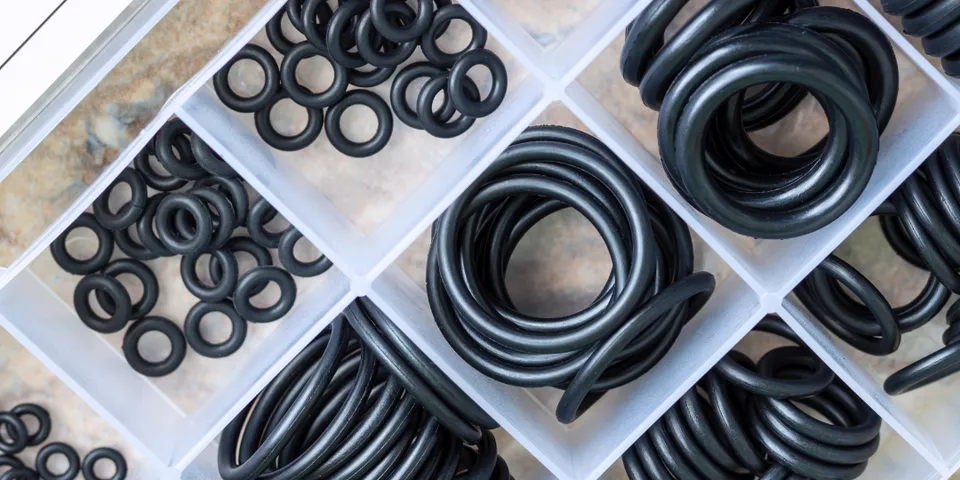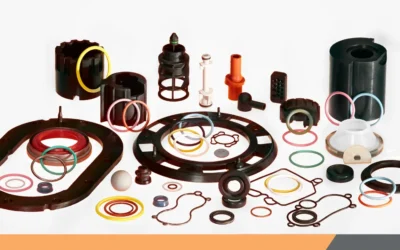Rubber O-rings are gaskets that help seal and block paths through which liquids or gases would otherwise escape. The rubber allows the ring to maintain its shape, even when high amounts of pressure are exerted on it, providing a durable and dependable solution. Review this guide to learn more about why and how O-rings are used.
 O-rings are used in a variety of applications, all of which need to keep liquid or gas from escaping to ensure the functionality of the product. They’re widely used in plumbing products, especially sinks. They hold the faucet in place and prevent water from leaking around the edges.
Many different medical devices rely on O-rings. Syringes, pumps, respirators, and even dental implants need these products to maintain their efficacy and smooth operation.
You can find O-rings in the food and beverage industry as well. Kitchen equipment often contains these helpful tools. At the beverage station or bar, O-rings seal the tubing around the keg or soda package so that the liquid can reach the tap.
Transportation industries utilize O-rings on a range of automotive and aerospace parts. Their ability to withstand extreme temperatures, chemical exposure, and vibrations make them ideal for engines, transmissions, fuel tanks, and other essential transportation equipment.
O-rings are used in a variety of applications, all of which need to keep liquid or gas from escaping to ensure the functionality of the product. They’re widely used in plumbing products, especially sinks. They hold the faucet in place and prevent water from leaking around the edges.
Many different medical devices rely on O-rings. Syringes, pumps, respirators, and even dental implants need these products to maintain their efficacy and smooth operation.
You can find O-rings in the food and beverage industry as well. Kitchen equipment often contains these helpful tools. At the beverage station or bar, O-rings seal the tubing around the keg or soda package so that the liquid can reach the tap.
Transportation industries utilize O-rings on a range of automotive and aerospace parts. Their ability to withstand extreme temperatures, chemical exposure, and vibrations make them ideal for engines, transmissions, fuel tanks, and other essential transportation equipment.
Function & Properties
An O-ring is fitted into a groove and secured in place before being compressed between two surfaces. The compression holds the ring tightly so that there’s no room for it to move, creating a seal that blocks the pathway of the liquid or gas you’re trying to contain. For more than a century, O-rings have been prized for their many beneficial properties. They can easily withstand extreme temperatures. Depending on the type of rubber used, an O-ring can maintain its form and function in conditions ranging from -75 degrees to 450 degrees. Rubber O-rings are compatible with a variety of liquids and gases. They work well with hot water, steam, grease, hydraulic fluids, and certain chemicals.Applications
 O-rings are used in a variety of applications, all of which need to keep liquid or gas from escaping to ensure the functionality of the product. They’re widely used in plumbing products, especially sinks. They hold the faucet in place and prevent water from leaking around the edges.
Many different medical devices rely on O-rings. Syringes, pumps, respirators, and even dental implants need these products to maintain their efficacy and smooth operation.
You can find O-rings in the food and beverage industry as well. Kitchen equipment often contains these helpful tools. At the beverage station or bar, O-rings seal the tubing around the keg or soda package so that the liquid can reach the tap.
Transportation industries utilize O-rings on a range of automotive and aerospace parts. Their ability to withstand extreme temperatures, chemical exposure, and vibrations make them ideal for engines, transmissions, fuel tanks, and other essential transportation equipment.
O-rings are used in a variety of applications, all of which need to keep liquid or gas from escaping to ensure the functionality of the product. They’re widely used in plumbing products, especially sinks. They hold the faucet in place and prevent water from leaking around the edges.
Many different medical devices rely on O-rings. Syringes, pumps, respirators, and even dental implants need these products to maintain their efficacy and smooth operation.
You can find O-rings in the food and beverage industry as well. Kitchen equipment often contains these helpful tools. At the beverage station or bar, O-rings seal the tubing around the keg or soda package so that the liquid can reach the tap.
Transportation industries utilize O-rings on a range of automotive and aerospace parts. Their ability to withstand extreme temperatures, chemical exposure, and vibrations make them ideal for engines, transmissions, fuel tanks, and other essential transportation equipment.


